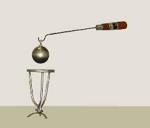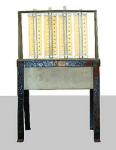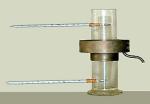Description
Upon and under the sleeve, through two holes in the test tube, we introduce two
thermometers. After filling the test tube with water, the two thermometers will show the
same temperature. When we put a mixture of ice and salt, as the water gets cooler, it falls
to the bottom and at once the temperature of the lower thermometer falls down, while the
upper thermometer stays almost stationary.
From then on the temperature of the upper thermometer will go down, reaching almost
grade 0, while the lower thermometer stays on grade 4, because the water at grade 4 has
reached its maximum specific weight and so cannot be substituted by colder water.
|


 Menu
Menu







